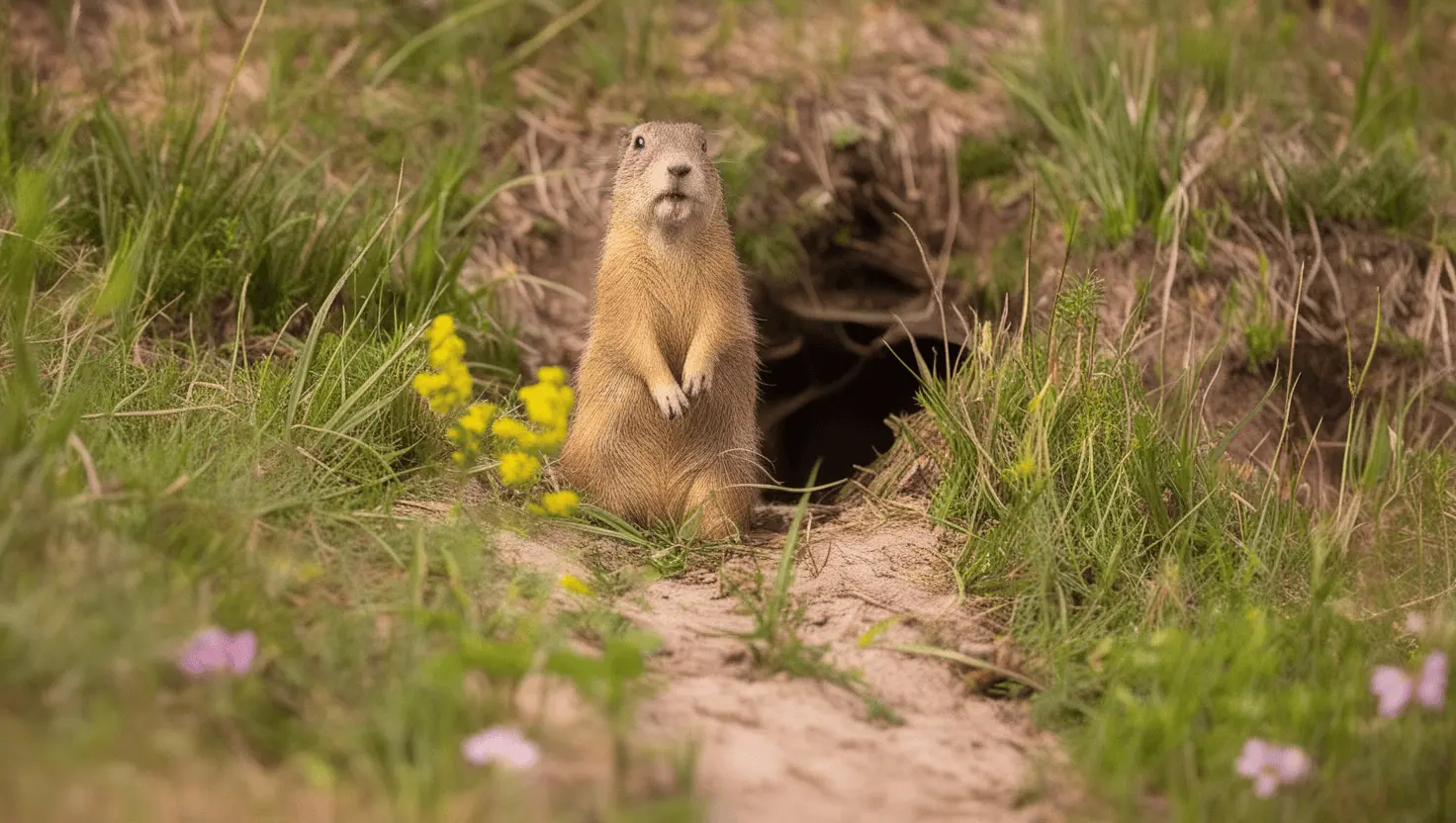If your garden or yard is under siege by groundhogs, also known as woodchucks, you’re not alone. These burrowing rodents can cause extensive damage to gardens, lawns, and even building foundations. While getting rid of groundhogs may seem challenging, several natural, humane methods can help you reclaim your outdoor space without harming the animals. Here are seven proven strategies you can use to deter groundhogs from your property safely.
1. Use Predator Urine to Repel Groundhogs
One of the most effective ways to get rid of groundhogs is to exploit their natural fear of predators. Predator urine, such as that from cats, coyotes, or foxes, is a powerful deterrent. You can collect used kitty litter soaked with cat urine and spread it around the areas where groundhogs are active. The strong smell will send them scurrying away in search of a safer location.
For those who don’t have access to cats, you can purchase coyote or fox urine from garden supply stores. Make sure to reapply the urine regularly, especially after it rains, to maintain its effectiveness. This method is cost-effective and safe for both groundhogs and pets.
2. Epsom Salt as a Natural Groundhog Repellent
Epsom salt is another budget-friendly solution to deter groundhogs. Groundhogs dislike the taste and smell of Epsom salt, so sprinkling it around the perimeter of your garden or near their burrows can encourage them to move away. Since Epsom salt can wash away with rain, be prepared to reapply it regularly for continued protection.
Not only is this method humane, but it’s also completely natural and non-toxic, making it a great choice for those looking to avoid harsh chemicals in their yard.
3. Commercial Groundhog Repellents

If homemade remedies don’t seem to be enough, there are a number of commercial repellents specifically designed to deal with groundhogs. These repellents come in both granular and liquid forms. The granular repellents work by releasing an odor that groundhogs find offensive, and they are often applied directly into the burrows or spread around the garden’s edges.
Liquid repellents, on the other hand, use taste as a deterrent. Spraying these repellents around your garden’s perimeter can keep groundhogs from munching on your plants. Just be sure to avoid spraying them directly on any crops you intend to eat.
4. Motion-Detecting Sprinklers to Scare Away Groundhogs
A more high-tech approach to deterring groundhogs is to use motion-activated sprinklers. These sprinklers detect movement and shoot a burst of water whenever something comes close. Groundhogs, like many animals, do not appreciate sudden sprays of water, and this surprise will likely cause them to flee the area.
Keep in mind, however, that motion-detecting sprinklers will activate for any movement, including pets or humans. You’ll want to place them in lower-traffic areas or use them around specific areas, like your garden, where groundhog activity is a concern.
5. Install Fencing or Row Covers
Building a physical barrier is one of the most effective ways to keep groundhogs out of your garden. Fencing made of chicken wire or other durable materials can provide a long-lasting solution to groundhog problems. For best results, the fence should be at least three to four feet high and buried about a foot deep to prevent groundhogs from burrowing underneath.
Additionally, leaving the top foot of the fence unattached and bent outward at a 90-degree angle will deter climbing. If you’re only concerned about protecting crops, floating row covers can also work well, keeping groundhogs and other critters from accessing your plants.
6. Plant Groundhog-Repelling Herbs and Flowers
Groundhogs have a highly sensitive sense of smell, which means you can use certain plants and herbs as natural repellents. Groundhogs detest the scents of garlic, lavender, mint, rosemary, sage, thyme, and oregano. By incorporating these plants into your garden, you can naturally discourage groundhogs from nibbling on your crops.
Additionally, some flowers, like daffodils and butterfly weed, are also known to repel groundhogs. These plants not only add beauty to your yard but also serve as a natural line of defense against these pests.
7. Remove Groundhog Habitats
Groundhogs are drawn to areas where they can easily dig burrows and find food. By removing their preferred habitats, you can make your yard less inviting. Start by clearing away any overgrown vegetation, tall grass, or brush piles near your home. Groundhogs prefer to dig burrows in areas where they feel safe and hidden, so keeping your lawn neatly trimmed will discourage them from settling in.
Another tip is to fill in any abandoned burrows with crushed stone or other materials. Groundhogs are less likely to return to an area where their burrows have been destroyed. Just make sure the burrow is no longer active before sealing it off, as you don’t want to trap any animals inside.
Bonus Tip: Use Hair Clippings as a Deterrent
Groundhogs have a natural aversion to human scent. One simple way to get rid of groundhogs is to spread human hair clippings around your garden or near burrow entrances. The smell will make them think twice about hanging around. You can often get hair clippings for free from a local barber or hair salon.
To ensure the clippings don’t blow away, consider placing them in mesh bags and securing the bags to the ground near vulnerable areas.
Trapping and Relocation: A Last Resort
If you’ve tried all the natural deterrents without success, you might consider trapping and relocating the groundhogs. Live traps are a humane way to capture the animals without harming them. However, before attempting to trap a groundhog, check your local regulations—relocation may be illegal in some areas, or it might require a permit.
Relocating groundhogs should be done by professionals whenever possible, as it ensures the animals are moved to a safe and suitable environment.
How to Prevent Future Groundhog Problems
Once you’ve successfully gotten rid of groundhogs, taking steps to prevent future infestations is crucial. Here are some preventive measures to keep your yard groundhog-free:
- Remove any potential food sources, such as fallen fruit, dandelions, or clover.
- Regularly mow your lawn and clear away any overgrown brush.
- Use crushed stone or hardware cloth to block access to burrow entrances under sheds, decks, or other structures.
In conclusion, groundhogs can cause significant damage to gardens and properties, but there are many humane and natural ways to deter them. From using predator urine and Epsom salt to installing motion-detecting sprinklers and row covers, you have a variety of effective options. Removing groundhog habitats and using natural repellents can also prevent future infestations. By choosing non-lethal methods, you can protect your garden while ensuring that groundhogs are safely relocated or encouraged to move on without harm.

